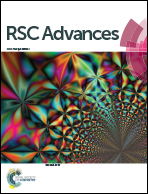Synthesis and characterization of polystyrene-graft-polythiophene via a combination of atom transfer radical polymerization and Grignard reaction†
Abstract
In this paper, a new strategy for synthesis of polystyrene-graft-polythiophene (PSt-g-PTh) is explored. For this purpose, first poly(styrene-co-acrylonitrile) (PSt-co-PAN) was synthesized via atom transfer radical polymerization (ATRP), and then the nitrile groups of acrylonitrile units were converted to thiophene groups using Grignard reaction between 2-thienylmagnesium bromide and nitrile groups to produce a thiophene-functionalized polystyrene macromonomer (ThPStM). The graft copolymerization of thiophene monomers onto polystyrene backbone was initiated by oxidized thiophene groups after addition of ferric chloride (FeCl3), an oxidative catalyst for polythiophene synthesis, and FeCl3-doped polythiophene was chemically grafted onto the polystyrene backbone via oxidation polymerization. The graft copolymer obtained was characterized by 1H nuclear magnetic resonance (NMR), and Fourier transform infrared (FTIR) spectroscopy, and its electroactivity behavior was verified under cyclic voltammetric conditions. Moreover, thermal behaviors of the synthesized polymers were investigated by means of differential scanning calorimetry (DSC), and thermogravimetric analysis (TGA).


 Please wait while we load your content...
Please wait while we load your content...